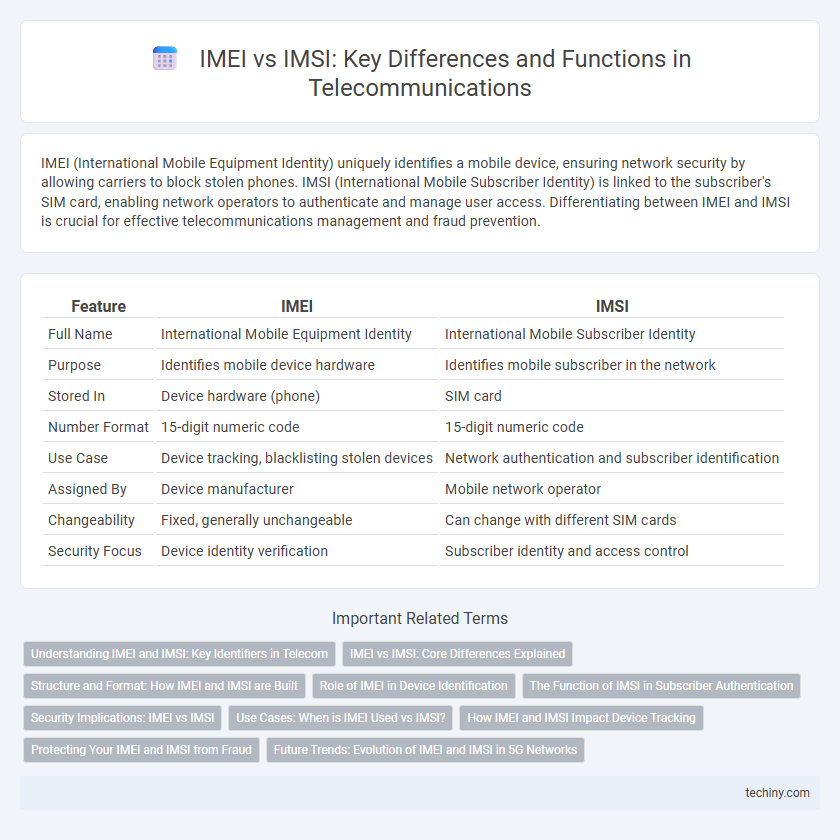IMEI (International Mobile Equipment Identity) uniquely identifies a mobile device, ensuring network security by allowing carriers to block stolen phones. IMSI (International Mobile Subscriber Identity) is linked to the subscriber's SIM card, enabling network operators to authenticate and manage user access. Differentiating between IMEI and IMSI is crucial for effective telecommunications management and fraud prevention.
Table of Comparison
| Feature | IMEI | IMSI |
|---|---|---|
| Full Name | International Mobile Equipment Identity | International Mobile Subscriber Identity |
| Purpose | Identifies mobile device hardware | Identifies mobile subscriber in the network |
| Stored In | Device hardware (phone) | SIM card |
| Number Format | 15-digit numeric code | 15-digit numeric code |
| Use Case | Device tracking, blacklisting stolen devices | Network authentication and subscriber identification |
| Assigned By | Device manufacturer | Mobile network operator |
| Changeability | Fixed, generally unchangeable | Can change with different SIM cards |
| Security Focus | Device identity verification | Subscriber identity and access control |
Understanding IMEI and IMSI: Key Identifiers in Telecom
IMEI (International Mobile Equipment Identity) is a unique 15-digit code assigned to mobile devices for identifying hardware, essential for device tracking and blocking stolen phones. IMSI (International Mobile Subscriber Identity) is a distinct number used by mobile networks to recognize a subscriber, stored on the SIM card, enabling authentication and service access. Together, IMEI and IMSI ensure secure device identification and subscriber management in telecommunications.
IMEI vs IMSI: Core Differences Explained
IMEI (International Mobile Equipment Identity) is a unique 15-digit number assigned to mobile devices for identification and tracking, whereas IMSI (International Mobile Subscriber Identity) is a unique identifier stored on SIM cards representing the subscriber's identity within a mobile network. IMEI primarily identifies the physical device, enabling network providers to block stolen or unauthorized equipment, while IMSI authenticates the user and manages subscriber services during network access. Understanding the core differences between IMEI and IMSI is essential for telecommunications security, device management, and subscriber authentication processes.
Structure and Format: How IMEI and IMSI are Built
The IMEI (International Mobile Equipment Identity) consists of a 15-digit number including the Type Allocation Code (TAC), serial number, and check digit, uniquely identifying mobile devices. The IMSI (International Mobile Subscriber Identity) is a 15-digit number stored on the SIM card, composed of the Mobile Country Code (MCC), Mobile Network Code (MNC), and Mobile Subscriber Identification Number (MSIN) that identifies individual subscribers. While IMEI focuses on device identification with fixed formatting, IMSI targets subscriber identity with a hierarchical structure based on geographic and operator codes.
Role of IMEI in Device Identification
The IMEI (International Mobile Equipment Identity) serves as a unique identifier for mobile devices, enabling network operators to track and block stolen or unauthorized phones. Unlike IMSI, which identifies the subscriber on the cellular network, the IMEI is tied to the physical device itself, ensuring accurate device authentication and enhancing security protocols. This differentiation is critical for fraud prevention, device warranty management, and network integrity in telecommunications.
The Function of IMSI in Subscriber Authentication
The International Mobile Subscriber Identity (IMSI) plays a crucial role in subscriber authentication by uniquely identifying a user within a mobile network, enabling secure access to services. Stored on the SIM card, the IMSI is transmitted to the network during registration, allowing the home network to authenticate the subscriber through the Authentication Center (AuC). This process ensures that only legitimate users gain connectivity, preventing unauthorized access and maintaining network security.
Security Implications: IMEI vs IMSI
IMEI (International Mobile Equipment Identity) serves as a unique identifier for mobile devices, enabling network operators to blacklist stolen phones and prevent unauthorized access. IMSI (International Mobile Subscriber Identity) identifies the subscriber within the network and is crucial for user authentication and session establishment. Protecting IMSI is critical to prevent identity theft, location tracking, and unauthorized interception, whereas IMEI protection mainly helps mitigate device-related fraud and cloning threats.
Use Cases: When is IMEI Used vs IMSI?
IMEI is primarily used for device identification, enabling network operators to track, blacklist, or unlock specific mobile handsets to prevent theft or fraud. IMSI is essential for subscriber identification within the mobile network, facilitating user authentication, billing, and service provision tied to a particular SIM card. IMEI is often leveraged in device management and security protocols, while IMSI is central to subscriber-related operations and network access control.
How IMEI and IMSI Impact Device Tracking
IMEI (International Mobile Equipment Identity) uniquely identifies a mobile device, enabling precise hardware tracking and theft prevention. IMSI (International Mobile Subscriber Identity) links to the user's SIM card, allowing network providers to monitor subscriber activity and location through cellular networks. Combined, IMEI and IMSI facilitate comprehensive device tracking by correlating physical device identity with subscriber information for enhanced security and network management.
Protecting Your IMEI and IMSI from Fraud
Protecting your IMEI and IMSI from fraud is essential in telecommunications security to prevent identity theft and unauthorized access to mobile networks. IMEI (International Mobile Equipment Identity) uniquely identifies a device, while IMSI (International Mobile Subscriber Identity) identifies the subscriber within the cellular network. Employing encryption technologies, secure SIM cards, and regular monitoring can mitigate risks associated with SIM swapping, cloning, and device tampering, thereby safeguarding personal information and network integrity.
Future Trends: Evolution of IMEI and IMSI in 5G Networks
The evolution of IMEI and IMSI in 5G networks centers on enhanced security, faster device authentication, and improved user privacy through advanced encryption techniques. Future standards integrate dynamic IMEI and IMSI allocation to support massive IoT connectivity and reduce fraud risks in smart cities and autonomous systems. Network operators leverage AI-driven analytics on IMEI and IMSI data to optimize resource allocation and maintain seamless seamless communication in ultra-dense 5G environments.
IMEI vs IMSI Infographic

 techiny.com
techiny.com